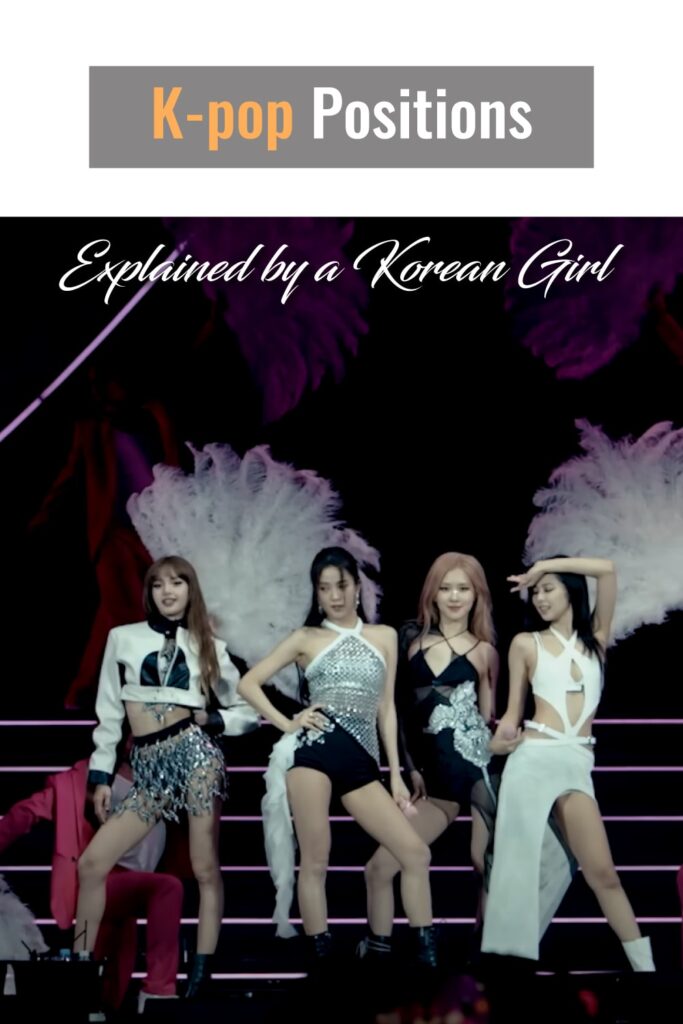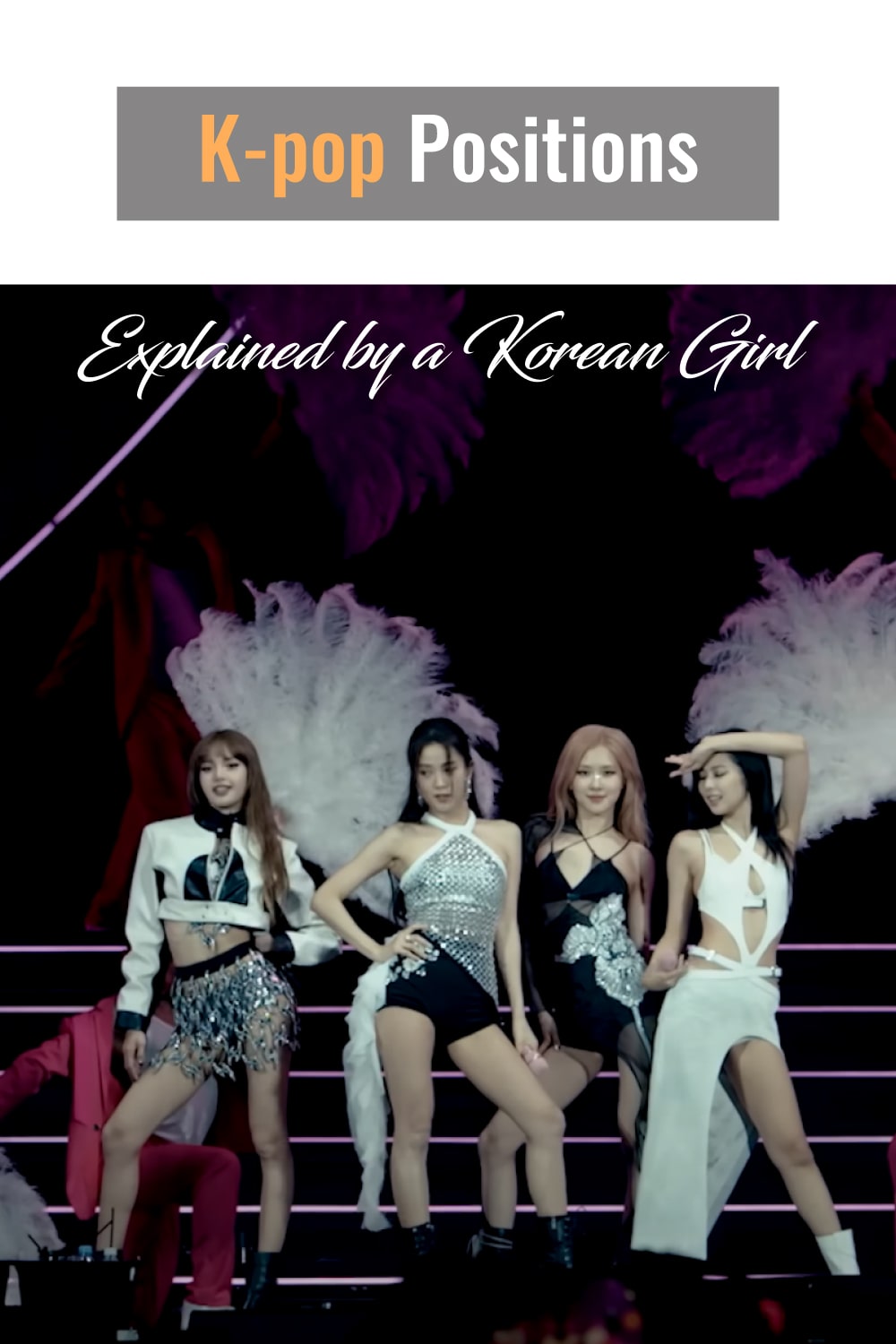Ever notice your favorite K-pop artist mentioning their position?
Not sure what meh-boh (메보), meh-dan (메댄) or meh-rap (메랩) mean?
This post will help you understand K-pop group positions and what roles they play!

Quick Summary
- K-pop positions are the roles of boy or girl group members.
- Vocalist: Main Vocalist, Lead Vocalist, Sub Vocalist
- Rapper: Main Rapper, Lead Rapper, Sub Rapper
- Dancer: Main Dancer, Lead Dancer
- Others: Producer, Center, Visual, Leader, Maknae, All-Rounder, One Top
What does “position” mean in the world of K-pop?
K-pop group positions are the roles of boy or girl group members that help make the magic happen.
While some positions are official, like vocalist, rapper, dancer, leader and maknae, other roles are implicitly assigned by the agency or known among fans.
A member can play many roles with multiple positions, and multiple members can also hold the same position.
They’ve been in use since the first generation K-pop idols like H.O.T., Sechs Kies, S.E.S. and Fin.K.L.
VOCALIST
📌 We love shortening things, so Koreans call a vocalist, “vocal (보컬)“, pronounced more like “boh-kul“, cause we don’t have Vs in hangeul.
For simplicity’s sake, I’ll use vocalist in this article.
1. Main Vocalist
The unicorn of the group.
Also known as “meh-boh (메보)” in Korean, a main vocalist is the best singer.
They get the most lines in a song, including the hardest part, climax, and chorus.
Main vocalists often make their solo debut at some point, collaborate with other groups, get featured in other solo artists’ music, or sing a K-drama OST (original sound track). Some will even participate in songwriting, composing, and producing!
Examples (in alphabetical order):
- Jung Kook of BTS
- Rosé of BLACKPINK
- Taeyang of BIGBANG
- Taeyeon of Girls’ Generation (SNSD)
🎤 Finding a main vocalist is like finding a needle in a haystack
Even major agencies delay a debut because they have trouble discovering a main vocalist.
I don’t know why, but Korea has so many good singers (probably all those noraebang). And still, main vocalists are RARE as they need to sing well, but in an idol-like manner, suited to pop music.
On top of that, they need to look pretty/handsome, have a certain level of dance skills to keep up with perfectly matching choreography, and be able to harmonize with the group.
Oh, I almost forgot! They also need a clean track record in both personal life and school as these issues can end the entire band.
2. Lead Vocalist
Contrary to how it sounds, a lead vocalist has the second best singing technique, after the main.
They bring stability by leading the song, and support the musicality of a group with their unique tone.
Actually, the OG K-pop idols in the 90s used main/lead vocalists interchangeably.
However, as the number of group members swelled to around 10, they divided the vocal position to allow members to specialize.
Lead vocalists get a decent number of lines, and sing the chorus.
Examples (in alphabetical order):
- Jimin of BTS
- Jisoo and Jennie of BLACKPINK
- Suho of EXO
- Sunny, Tiffany and Seohyun of Girls’ Generation (SNSD)
3. Sub Vocalist
A sub-vocalist refers to vocal members other than the main/lead vocalists (this excludes rappers which I’ll cover next).
Sometimes, a simple “vocalist” is used to distinguish vocal members from rappers (for example, vocal line vs. rapper line).
Sub-vocal members tend to have superior visual or dance skills, or more recently, pursue acting or careers in entertainment.
This position usually sings a line or two at the beginning of a song or during a bridge.
Some groups have strong sub-vocalists who can top lead vocalists, like Max Changmin of TVXQ and Yook Sungjae of BtoB.
Examples (in alphabetical order):
- Jin and V of BTS
- Lisa of BLACKPINK

RAPPER
📌 The rapper position used to go to a member who couldn’t sing or who’s fluent in English in the 90s.
Luckily, things have changed. Since the late 2000s, agencies have recognized the importance of rappers in idol groups, and have begun to accept trainees with rapping skills.
BIGBANG’s G-Dragon received numerous shout-outs from top rappers for his solo album, One of a Kind. And second generation idol rappers such as Zico, Song Minho, and BOBBY gradually gained recognition among hip-hop fans.
4. Main Rapper
Also known as meh-rap (메랩), a main rapper gets the most lines and has the best technique.
They often write their own lyrics, write for the group or even take on the role of producer, and be featured on other singers’ songs.
Unlike the main vocalist, they can have a few skeletons in their closet, because street cred.
Examples (in alphabetical order):
- Changbin of Stray Kids
- CL of 2NE1
- G-Dragon of BIGBANG
- Jennie of BLACKPINK
- LE of EXID
- RM of BTS
5. Lead Rapper
A lead rapper has the next best technique after the main.
They’re good enough to lead the group’s rap, and might start on rap parts before the main rapper.
Examples (in alphabetical order):
- Lisa of BLACKPINK
- Suga of BTS
6. Sub Rapper
A sub-rapper is better than the vocal members, but not good enough to be the main/lead.
They could be an all-rounder, or change the pattern of a song.
This position is mostly a tactic to add a verse or two to give lesser-known members more airtime, or to increase the parts of popular members.

DANCER
📌 Since everyone in a k-pop group dances, everyone is technically a dancer.
More skilled members become either the main or lead dancer.
7. Main Dancer
Also known as “meh-dan (메댄)“, a main dancer takes center stage in dance breaks, and makes their presence felt during difficult solo parts.
They usually represent the group in talent shows (which are a very common format on Korean TV).
Main dancers may have majored in ballet, modern dance, or street dance before their debut.
In case of multinational idol groups, non-Korean members often fill this position.
Examples (in alphabetical order):
- J-Hope and Jimin of BTS
- Lisa of BLACKPINK
- Mimi and YooA of Oh My Girl
- Taeyong of NCT
8. Lead Dancer
A lead dancer has, you guessed it, the second best dancing skills after the main.
They’re usually found in front, providing a sense of center, together with the main.
Regardless of main or lead dancer roles, they still need to perform as a vocalist or rapper.
In general, members with a dancer position tend to be rappers or sub-vocalists.
Examples (in alphabetical order):
- Jung Kook of BTS
- Rosé of BLACKPINK
Sub Dancer Position?
There’s no sub-dancer position, because everyone is a dancer in a K-pop idol group!
OTHERS
9. Producer
The producer position is relatively new.
Rapper members tend to become a producer of the group as they have experience in rap/beat making.
They know the characteristics of other members better than anyone else, so they naturally bring out the hidden tones and personalities of their fellow members.
Producers contribute to the musical color of the band, and generate additional revenue through copyrights. Agencies love them because they can promote them as artists, leading to more moneys.
Examples (in alphabetical order):
- G-Dragon of BIGBANG
- LE of EXID
- Soyeon of (G)I-DLE
- Suga, RM and J-Hope of BTS
10. Center
A center position refers to the member who’s in the “center” or front during interviews, photoshoots, and performances.
This position usually goes to the team’s visual, main vocalist, or main dancer.
It implies that they’re the “ace” most promoted by their agency.
Examples (in alphabetical order):
- Cha Eun-woo of Astro
- Irene of Red Velvet
- Kai of EXO
- Yoona of Girls’ Generation (SNSD)
11. Visual
A visual position refers to a member in charge of the group’s appearance, pretty much the hottest one according to Korean beauty standards.
The agency often puts them first in the debut teaser video to attract attention, so they’re in charge of securing initial group recognition along with the main vocalist.
With consistent popularity from the beginning of their debut, visual members usually become the center.
When they decide to pursue solo careers, they often become actors/actresses.
Every k-pop idol is a visual member, but the most famous examples (in alphabetical order) are:
- Cha Eun-woo of Astro
- Jin of BTS
- Wonyoung of IVE
Physical Member (피지컬 담당)?
Formally known as the position in charge of “abs”, it refers to a member who shows off a muscular body within a boy group.

12. Leader
A leader is the glue that holds it all together.
They represent the group externally, control it internally, and act as a liaison between the agency and the members.
It’s kind of a thankless and stressful job, as they need to resolve conflicts and unite team members.
That being said, a leader role requires mental strength, patience, and leadership more than a pretty face, singing ability, and popularity.
Usually, the oldest member, the one who trained the longest, or the main vocalist takes on the leader role.
Some bands like BLACKPINK don’t have an official leader.
Examples (in alphabetical order):
- Bang Chan of Stray Kids
- Karina of aespa
- RM of BTS
- Taeyeon of Girls’ Generation (SNSD)
13. Maknae
Maknae is the role held by the youngest member of a group.
As being young itself is a major selling point for k-pop bands, the average age of idols is decreasing. And naturally, maknae are getting younger and younger.
There’s also a term, “maknae line“, to distinguish younger members from the “hyung line“.
Contrary to what you might expect, maknae aren’t always the lowest man/woman on the totem pole. Some become “maknae on top” and lead the group.
Examples (in alphabetical order):
- Hyein of NewJeans
- Jung Kook of BTS
- Leeseo of IVE
- Sehun of EXO
- Taemin of SHINee
- Tzuyu of TWICE

14. All-Rounder
All-rounder’s have it all.
It’s a term used by fans, not an official position, referring to someone with a versatile set of skills.
They’re good at singing, dancing, acting, and producing, on top of being beautiful and witty.
In many cases, their official profile shows more than two main or lead positions at the same time.
Examples (in alphabetical order):
- Jennie of BLACKPINK
- Jung Kook of BTS
- Yujin of IVE
15. One Top
The member whose arms are most tired from carrying everyone.
The One Top position is another unofficial title that goes to a member who performs “hard carry” for the group, or all the work to support them.
With their absolute presence, the fate of the band depends on this One Top member.
In case of a strong polarization of popularity, their individual performance can be better than the whole group’s. They’re often nicknamed the “child breadwinner”.
Examples (in alphabetical order):
- Cha Eun-woo of Astro
- Han Seung-yeon of KARA
- Hani of EXID
- Jung Yong-hwa of CNBLUE
- Niel of Teen Top
- Sejeong of Gugudan











Very nice and good explaination.
Thank you, Rya! ^^
Too much info! >:(
Thanks!